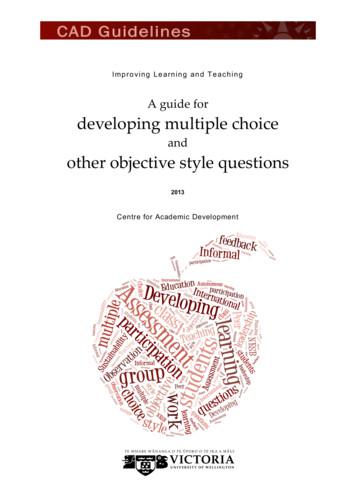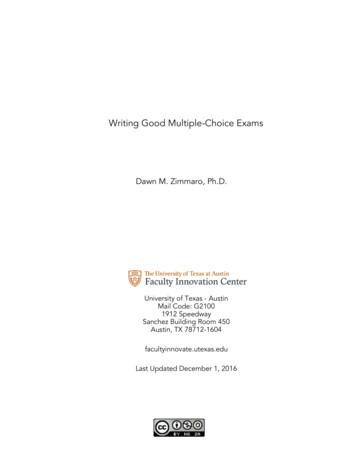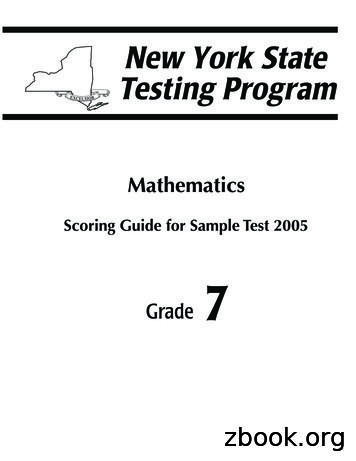MULTIPLE CHOICE QUESTIONS Part 5: Stereochemistry
Chapter 5Chapter 5MULTIPLE CHOICE QUESTIONS Part 5: StereochemistryAnswers on page 24-26Topic: Identifications and Comparisons5. Pairs of enantiomers are:CH3H3C1. Which of the following is the enantiomer of the following substance?HHHBrA)B)C)D)E)CH3BrHCH3CH3CH3BrHHIC CCHHO2CCH3HIIFIII3. Hexane and 3-methylpentane are examples of:A) enantiomers.B) stereoisomers.C) diastereomers.D) constitutional isomers.E) None of Iconstitutional isomers.enantiomers.non-superposable mirror images.diastereomers.not isomeric.1HCH2CH2CH3V6. Chiral molecules are represented by:CH3CH2CH3H3CVClCH3H 3CC2H5IIII, II, III, IV and VI, II, III and IVI and IIIII and IVIV aloneA)B)C)D)E)7. The molecules shown lHClIVI, II and III, IVI, IIIII, IVIV, VNone of the structuresCH34. I and II 2CH2CH3A)B)C)D)E)ClIHCO2HHHH3CCH2CH2CH3H3C2. Which of the following molecules is achiral?H 3CHCH3CH2CH2CH3IIIIIIIIIIt does not have a non-superposable enantiomer.Both II and IIIClCH2CH2CH3HBrHIICH3ClHCH3constitutional isomers.enantiomers.diastereomers.identical.None of these2ClH 3CClCH2ClHHC2H5HC 2H 5IIIIVV
Chapter 5Chapter 5The8. The molecules shown are:12. The molecules shown eenantiomers.diastereomers.constitutional isomers.two conformations of the same molecule.not isomeric.HHCH3A)B)C)D)E)constitutional isomers.enantiomers.diastereomers.identical.None of theseHHFHHCH3FHFconstitutional isomers.enantiomers.diastereomers.identical.None of theseA)B)C)D)E)10. The molecules below are:FOH13. The molecules shown are:CH3HOHHCH2CH39. The molecules shown are:A)B)C)D)E)CH3HFconstitutional isomers.enantiomers.diastereomers.identical.None of these14. The molecules below are:HCH3HHCH3HHFHHFFA)B)C)D)E)constitutional isomers.CH3A)B)C)D)E)11. The molecules shown rs.diastereomers.constitutional isomers.two different conformations of the same molecule.not isomeric.3structural isomers.enantiomers.diastereomers.identical.None of these15. Cis-trans isomers are:A) diastereomers.B) enantiomers.C) stereoisomers.D) constitutional isomers.E) More than one of theseAns: E4
Chapter 516. The molecules below are:20. The molecules below are:ClCH3ClFBrCH3IIIA)B)C)D)E)constitutional isomers.enantiomers.diastereomers.identical.None of 21. Which molecule is achiral?CH3CH3ClCH3Cl17. The molecules below are:H2NHHconstitutional isomers.enantiomers.diastereomers.identical.None of theseHHHBrFA)B)C)D)E)Chapter 5ClNH2constitutional isomers.enantiomers.diastereomers.identical.None of these18. The molecules shown are:HCH3FFBrIII22. Which molecule is achiral?A)B)C)D)E)Hconstitutional isomers.enantiomers.diastereomers.identical.None of D)E)19. The molecules below are:BrHClIHHClHIIIIIIIIMore than one of the aboveNone of the aboveIIICH3constitutional isomers.enantiomers.diastereomers.identical.None of these5BrBrIIIIIIIIIMore than one of theseNone of theseA)B)C)D)E)Br6
Chapter 5Chapter 526. Which structure(s) represent(s) diastereomer(s) of I?23. The molecules below are:HHHFFHHHFHHHHHOHOHHA)B)C)D)E)IFA)B)C)D)E)24. The HOHCH3CH3HHOHCH3OHCH3OHHCH3IVVHOHIIIHHHOIIII and IIIII and IVIII and VIV and 3OHHCH3IIIIVVI and IIII and IIIIII and IVIII and VIV and VHOHHHHOFHBrFA)B)C)D)E)25. Which pair of structures represents the same compound?CH3OHH27. The two compounds shown below are:CH3CH3represent:A) a single compound.B) enantiomers.C) meso forms.D) diastereomers.E) conformational isomers.HHHHHIIIconstitutional isomers.enantiomers.diastereomers.identical.None of stereomers.constitutional isomers.identical.different but not isomeric.28. The two compounds shown below mers.diastereomers.conformational isomers.meso forms.29. (2R,4S) –2,4–Dichloropentane and (2S,4R)-2,4-dichloropentane are:A) enantiomersB) diastereomersC) identicalD) conformational isomersE) constitutional isomers78
Chapter 5Chapter 530. Which of the following is a meso H2OHOH33. Which of the following is(are) )C)D)E)HBrHBrBrIA)B)C)D)E)IIIIIIIIIVTwo of the IIIIIBoth II and IIIBoth I and re than one of theseNone of theseIII35. Which molecule has a plane of symmetry?H32. Which of the following molecules is achiral?A) (2R,3R)-2,3-DichloropentaneB) (2R,3S)-2,3-DichloropentaneC) (2S,4S)-2,4-DichloropentaneD) (2S,4R)-2,4-DichloropentaneE) Two of opic: Meso compounds34. Which molecule has a plane of symmetry?31. Which of the following is(are) meso compound(s)?ClBrHHFFIIIIIIIIIMore than one of theseNone of these10
Chapter 5Chapter 536. Which compound does NOT possess a plane of symmetry?HHClFFHHCH3H39. Which of the following substances is achiral ?BrBrHBrCH3ClHA)B)C)D)E)IBrIIIVIIII, II and VI, III and IVII, III and IVIII and E)CH3FVFHHBrIICH3BrHHOIIIIVIIIIIIIVMore than one of these40. Which statement is not true for a meso compound?A) The specific rotation is 0º.B) There are one or more planes of symmetry.C) A single molecule is identical to its mirror image.D) More than one stereogenic center must be present.E) The stereochemical labels, (R) and (S), must be identical for each stereogeniccenter.37. Which molecule is a meso compound?HHIA)B)C)D)E)CH3H41. Which is a meso compound?A) (2R,3R)-2,3-DibromobutaneB) (2R,3S)-2,3-DibromopentaneC) (2R,4R)-2,4-DibromopentaneD) (2R,4S)-2,4-DibromopentaneE) (2R,4S)-2,4-DibromohexaneIIIIIIMore than one of the aboveNone of the above38. Which molecule is a meso IIIIIVI and IIIV and VII and IIII, II and IIINone of the aboveVTopic: Specific names42. (R)-2-Chlorobutane is represented CClHHCH2CH3CH2CH3CH2CH3HCH2CH3IIIIIIIVVIIIIIIIVV12
Chapter 5Chapter 543. Which of the following represent CH3FFClHHHClCH3FIIIIIICH3HClClFCH3IIIIIIIIMore than one of the aboveNone of the aboveIII46. Which structure represents (S)-2-bromobutane?BrCH2CH3A)B)C)D)E)IBrH48. The Cahn-Ingold-Prelog stereochemical designations used for the following substanceare:HClClCl2R,4S2S,4R2R,4R2S,4SThe “R,S” terminology doesn't apply in this case.49. Which of these is not a correct Fischer projection formula of the (S) form of3-bromo-1,1-dichloro-2-propanol rOHH3CCH2CH3IIIIIIIIMore than one of the aboveNone of the H3His properly named:(3R,4S,5R)- 3,5-Dichloro-4-methylhexane(2S,3S,4S)- 2,4-Dichloro-3-methylhexane(2S,3R,4R)- -3-methylhexane(2S,3S,4R)- 2,4-Dichloro-3-methylhexaneA)B)C)D)E)FHCH3HCH3H45. Which structure represents (R)-1-chloro-1-fluoroethane?HCH3ClClIIIIIIMore than one of the aboveNone of the aboveFClHClCH3ClHA)B)C)D)E)44. Which structure represents (S)-1-chloro-1-fluoroethane?IOHCH2CH3III and VI, III, IV and VI, IV and VI and IIII, II, IV and HCH2CH347.HCH3H14BrH2COHCHCl2HV
Chapter 5Topic: Optical activityChapter 554. The compounds whose molecules are shown below would have:50. What is the percent composition of a mixture of (S)-( )-2-butanol,[!] 25 13.52º,Dand (R)-(-)-2-butanol,[!] 25 -13.52º, with a specific rotation [!] 25 6.76º?DDA) 75%(R) 25%(S)B) 25%(R) 75%(S)C) 50%(R) 50%(S)D) 67%(R) 33%(S)E) 33%(R) 67%(S)51. Which one of the following can exist in optically active forms?A) cis-1,3-DichlorocyclohexaneB) trans-1,3-DichlorocyclohexaneC) cis-1,4-DichlorocyclohexaneD) trans-1,4-DichlorocyclohexaneE) cis-1,2-DichlorocyclohexaneHOHOHA)B)C)D)E)the same melting point.different melting points.equal but opposite optical rotations.More than one of theseNone of theseCH2CH3HFHFCH2CH3CH3IIIA)B)C)D)E)the same melting point.different melting points.equal but opposite optical rotations.More than one of the aboveNone of the above53. The compounds whose molecules are shown below would have:CH3HFHCH3FA)B)C)D)E)CH3FHH3CFHthe same melting point.different melting points.equal but opposite optical rotations.More than one of the aboveNone of the above15HOHOH55. The compounds whose structures are shown below would have:CH3BrCH3CH3BrA)B)C)D)E)the same melting point.different melting points.equal but opposite optical rotations.More than one of theseNone of these52. The compounds whose molecules are shown below would have:CH3HHBrBrCH3(Ej .56. 57)58. Which of these is a comparatively insignificant factor affecting the magnitude ofspecific optical rotation?A) Concentration of the substance of interestB) Purity of the sampleC) Temperature of the measurementD) Length of the sample tubeE) All of the above are equally significant.59. What can be said with certainty if a compound has [!] 25 -9.25º ?DA) The compound has the (S) configuration.B) The compound has the (R) configuration.C) The compound is not a meso form.D) The compound possesses only one stereogenic center.E) The compound has an optical purity of less than 100%.16
Chapter 5Chapter 560. An alkane which can exhibit optical activity is:A) NeopentaneB) IsopentaneC) 3–MethylpentaneD) 3–MethylhexaneE) 2,3–Dimethylbutane67. Enantiomers are:A) molecules that have a mirror image.B) molecules that have at least one stereogenic center.C) non-superposable molecules.D) non-superposable constitutional isomers.E) non-superposable molecules that are mirror images of each other.61. In the absence of specific data, it can only be said that (R)–2–bromopentane is:A) dextrorotatory ( ).B) levorotatory (–).C) optically inactive.D) achiral.E) analogous in absolute configuration to (R)–2–chloropentane.68. Which of the following is NOT true of enantiomers? They have the same:A) boiling point.B) melting point.C) specific rotation.D) density.E) chemical reactivity toward achiral reagents.62. If a solution of a compound (30.0 g/100 mL of solution) has a measured rotation of 15ºin a 2 dm tube, the specific rotation is:A) 50ºB) 25ºC) 15ºD) 7.5ºE) 4.0º69. Which statement is true of 1,3-dimethylcyclobutane?A) Only one form of the compound is possible.B) Two diastereomeric forms are possible.C) Two sets of enantiomers are possible.D) Two enantiomeric forms and one meso compound are possible.E) None of the previous statements is true.63. Which compound would show optical activity?A) cis 1,4- DimethylcyclohexaneB) trans 1,4- DimethylcyclohexaneC) cis 1,4- DimethylcycloheptaneD) trans 1,4- DimethylcycloheptaneE) More than one of these64. Of the compounds which correspond to the general name "dichlorocyclobutane", howmany are optically active?A) 0B) 1C) 2D) 3E) 4Topic: General definitions(Ej .65)66. Which of the following is true of any (S)-enantiomer?A) It rotates plane-polarized light to the right.B) It rotates plane-polarized light to the left.C) It is a racemic form.D) It is the mirror image of the corresponding (R)-enantiomer.E) It has the highest priority group on the left.1770. In which of the following reactions is the absolute configuration of the product likely tobe the same as that of the BrOHH2OOH(R)All of the aboveAnswers A) and B) onlyOHTopic: Reaction stereochemistry(Ej 71, 72)73.OThe reaction ofwith H2/Ni forms:A) 2-methylheptane.B) (R)-2-methyl-5-heptanolC) (S)-6-methyl-3-heptanolD) (R,S)-6-methyl-3-heptanolE) Achiral 6,6-dimethyl-3-hexanol18
Chapter 574. CH3CHBrCH2CHClCH3 is the generalized representation of what number ofstereoisomers?A) 3B) 4C) 5D) 6E) 775. For the generalized structure BrCH2CHClCH2CHClCH2Br there exists what number ofstereoisomers?A) 2B) 3C) 4D) 6E) 876. How many discrete dimethylcyclopropanes are there?A) 2B) 3C) 4D) 5E) 677. What is the molecular formula for the alkane of smallest molecular weight whichpossesses a stereogenic center?A) C4H10B) C5H12C) C6H14D) C7H16E) C8H1878. How many chiral stereoisomers can be drawn for CH3CHFCHFCH(CH3)2?A) 1B) 2C) 3D) 4E) 879. How many different compounds are there which correspond to the general name "3-(1methylbutyl)cyclobutanol”?A) 2B) 4C) 6D) 8E) None of the above19Chapter 580. How many stereogenic centers are there in Lovastatin ( Mevacor : a cholesterollowering drug) ?HOOOOA)B)C)D)E)(Lovastatin)4567881. What is the total number of compounds, stereoisomers included, designated by thegeneral name "dichlorocyclopentane"?A) 4B) 5C) 7D) 8E) 9Use the following to answer questions 82-85:Consider the following HCH3OHHOHIIIIIIIV82. Which of the compounds above (I-IV) represent enantiomers?A) I and IIB) II and IIIC) III and IVD) II and IVE) III and IV20
Chapter 583. Which compound above (I-IV) is a meso compound?A) IB) IIC) IIID) IVE) None of theseChapter 5SHORT ANSWER QUESTIONS Answers on p. 25-2686. The molecule of aspartame ( Nutrasweet ), depicted below, has ( howmany? ) stereogenic centers.OOHO84. Which compound above (I-IV) is (2R,3R)-2,3-butanediol?A) IB) IIC) IIID) IVE) None of these85. Which compounds above (I-IV) form a set of stereoisomers?A) I, II and IIIB) II, III and IVC) II and IIID) I, III and IVE) I, II, III and IVHNOOH2NAspartame87. True or false: A sample consisting of the pure R enantiomer of a compound will alwaysrotate plane-polarized light in a clockwise direction.A) TrueB) False88. Draw a dash-wedge structure for (3R)-3-methyl-5-hexen-3-ol89. Draw a dash-wedge structure for (1R)-1-bromo-1,3,3-trimethylcyclohexane90. Draw a dash-wedge structure for (1R,3R)-1,3-dibromo-1,3-dimethylcyclohexane91. Draw a dash-wedge structure for (1S,3R)-1-ethyl-1,3-dimethylcyclopentane92. What is the complete IUPAC name of the following substance? (Remember to givestereochemical details, as relevant.)HC2H5H3C21CH322
Chapter 593. What is the complete IUPAC name of the following substance? (Remember to givestereochemical details, as relevant.)HOHH3COH94. Draw Fischer projection formulas for all stereoisomers of 2,4-dibromohexane, givingstereochemical details for each structure.95. Draw dash-wedge structures for all stereoisomers of 1-bromo-3-isopropylcyclohexane,giving stereochemical details for each structure.Topic: Fischer projections96. Draw Fischer projection formulas for all stereoisomers of 2,4-dimethyl-3-hexanol,giving stereochemical details for each structure.97. Draw a Fischer projection formula of (3R)-6-Bromo-1-hexen-3-ol.23Chapter 5Svar Part 5: l
Chapter 5Chapter 596:Answer 86 – ropylcyclohexaneHHHHBr1S, 3RHBrHH1R, 3SBr1S, CH397:BrHHOCH3BrBrH3CH1R, 3R26
MULTIPLE CHOICE QUESTIONS Part 5: Stereochemistry Answers on page 24 -26 Topic: Identifications and Comparisons 1. Which of the following is the enantiomer of the following substance? H Br CH 3 H H H Br C3 H 3 r I II III A) I B) II C) III D) It does not have a non -superposable enantiom er. E) Both II and III 2.
Developing multiple choice and other objective style questions 4 2. Writing multiple choice questions THE FORMAT of a multiple choice question Multiple choice questions are the most commonly used format for presenting objective-style questions. A multiple choice question consists of two parts ñ A stem and several options or alternatives.
Figure 1: A two-tier multiple-choice question in the format suggested in this paper, used in an exam in 2014. 2Description and design of our two-tier multiple-choice questions 2.1Basic structure of our two-tier multiple-choice questions There are several different ways to formulate two-tier multiple-choice questions. The type of
Test Blueprint 10 Preparing to Write Items 11 Description of Multiple-Choice Items 12-15 Multiple-Choice Item Writing Guidelines 16-18 Guidelines to Writing Test Items 19 Sample Multiple-Choice Items Related to Bloom’s Taxonomy 21-23 More Sample Multiple-Choice Items 24-25 Levels of Performance and Sample Prototype Items 26 Good versus Poor Multiple-Choice Items 27-28 Activity: Identifying .
Using multiple choice questions in the classroom How multiple choice questions can aid knowledge retention and help teachers diagnose pupils’ understanding. Why might I use multiple choice questions with my students?
50 multiple choice. 5. field test 40 multiple choice field test 46 ITEMS/40 POINTS 45 ITEMS/40 POINTS 55 ITEMS/50 POINTS 45 ITEMS/40 POINTS. 12 Students compose two essays one, for each of. two writing prompts. 40. multiple choice. 5. field test. 49. multiple choice. 1. open ended. 6. field test 50 multiple choice. 5. field test 40 multiple .
choice questions. Part I is offered in the morning session and Part II in the afternoon session of each Exam administration. FRM Part I Exam will have 100 multiple-choice questions. FRM Part II Exam will have 80 multiple-choice questions. The FRM Part I Exam will cover the following top
Grade 7, Book 1 Question Type Points Strand Content Performance Indicator Answer Key 1 Multiple Choice 1 Number Sense and Operations 7.N.9 C 2 Multiple Choice 1 Algebra 7.A.1 G 3 Multiple Choice 1 Statistics and Probability 6.S.3 A 4 Multiple Choice 1 Number Sense and Operations 7.N.6 H 5 Multiple Choice 1 Geometry 7.G.3 B
Other Species of Multiple-Choice Items In this chapter, we are concentrating on only one type of multiple-choice item—the one that has only one correct answer—but there are several other types of more complex multiple-choice items that you may want to consider. Some multiple-choice items are context























